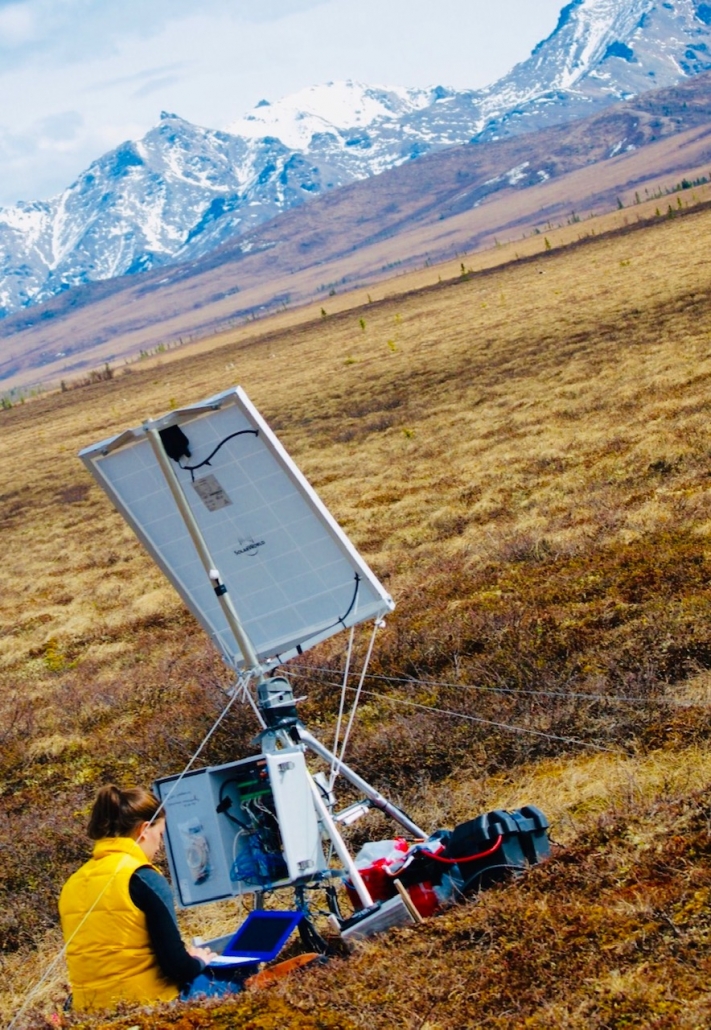In the summer of 2017, my first working in the lab, I assisted Christina Minion who constructed soil chambers and calibrated forced diffusion (FD) chambers to be sent to the Arctic. As an engineering student, this was outside my direct area of study and so it was all the more exciting to learn about! I never expected to see the chambers in action at research sites in the boreal forests of Alaska but the lucky flip of a coin (truly!) gave me that opportunity. A major benefit of being part of FluxLab is working with assorted scientists and students on diverse projects in various subject areas, which enables multi-disciplinary learning through hands on experience.
 In early May 2019, I boarded a flight at the Halifax airport for the long journey to Fairbanks, Alaska, where I would meet Christina, amongst the snow-covered-bear-roaming mountains, and learn more about the her research project, which is part of the NASA-funded Arctic Boreal Vulnerability Experiment (ABoVE). It was Christina’s sixth trip to the region as an environmental scientist, where she monitors Arctic greenhouse gas emissions. The sites we visited measure the seasonal changes in the CO2 flux and explore the main drivers of soil respiration.
In early May 2019, I boarded a flight at the Halifax airport for the long journey to Fairbanks, Alaska, where I would meet Christina, amongst the snow-covered-bear-roaming mountains, and learn more about the her research project, which is part of the NASA-funded Arctic Boreal Vulnerability Experiment (ABoVE). It was Christina’s sixth trip to the region as an environmental scientist, where she monitors Arctic greenhouse gas emissions. The sites we visited measure the seasonal changes in the CO2 flux and explore the main drivers of soil respiration.
Boreal forests of the arctic are major sources of carbon storage, which is largely stored in permafrost. With a warming climate, soil respiration is expected to increase due to the rise in temperature and moisture of the soil, two key drivers of soil respiration. A warmer climate also facilitates more rampant forest fires in Alaska’s densely tree-covered land, and this environmental disturbance further disrupts the temperature and moisture conditions leading to increased soil respiration. The increase in soil respiration may lead to the thawing of permafrost and the release of carbon into the atmosphere and thus a massive reduction of stored carbon.
During our ten-day trip, we visited six soil respiration stations located within a three-hour radius of Fairbanks. Sites were located in burned or unburned forests and the results present the changes in soil respiration at each. There are three FD chambers per site that rest at the surface and measure the CO2 flux. Three soil chambers are placed in the soil at set depths (5cm, 15cm and 25cm) to measure the soil temperatures and CO2 concentrations. A box holds data loggers and a pump, which allow for regulated pumping of the gasses from the FD chambers and the data from each chamber to be collected. There is also a moisture probe at a depth of 15cm and a temperature probe at a depth of 50cm. Providing the whole station with power is a solar panel that faces south, as well as at least two 12 Volt batteries to allow the station to continue running throughout the winter months when there is no more than a couple hours of sunlight. As I’m sure you can imagine, lugging the 50 LB batteries through the woods to the field sites was not the highlight of the trip…
The findings of this project confirm that the soil temperature and moisture are higher at burned sites compared to unburned sites. Moisture was consistently higher year-round at burned sites, and temperatures tended to be higher during the winter yet during the growing season were very similar to unburned sites. The soil respiration and the soil CO2 measurements were higher at burned sites as well. The temperature sensitivity (Q10) of the soil respiration showed to be much higher at the unburned site compared to the burned site.
Aside from engaging in science during the trip, I captured far too many photos of the constant mountainous backdrop and the effortless allure of Alaska’s nature. As for the wildlife, I saw a moose, some caribou, many rabbits, and my first two grizzly bears! Overall, it was an incredible experience to learn of the soil respiration project and to visit such a beautiful part of the world.
Working for FluxLab, I have been fortunate to explore areas of environmental science where I feel I have learned more than any university class could have taught me. I hope to use this knowledge and incorporate it into my work as an engineer in the future.
A big thank you to Christina for allowing me to tag along with her on her fieldwork, take many photos of her science in action and answering my endless questions with patience and ease. Many thanks to Sue Natali at WoodsHole Research Centre, and to Dave for granting me this wonderful opportunity.
By Meghan Flood




